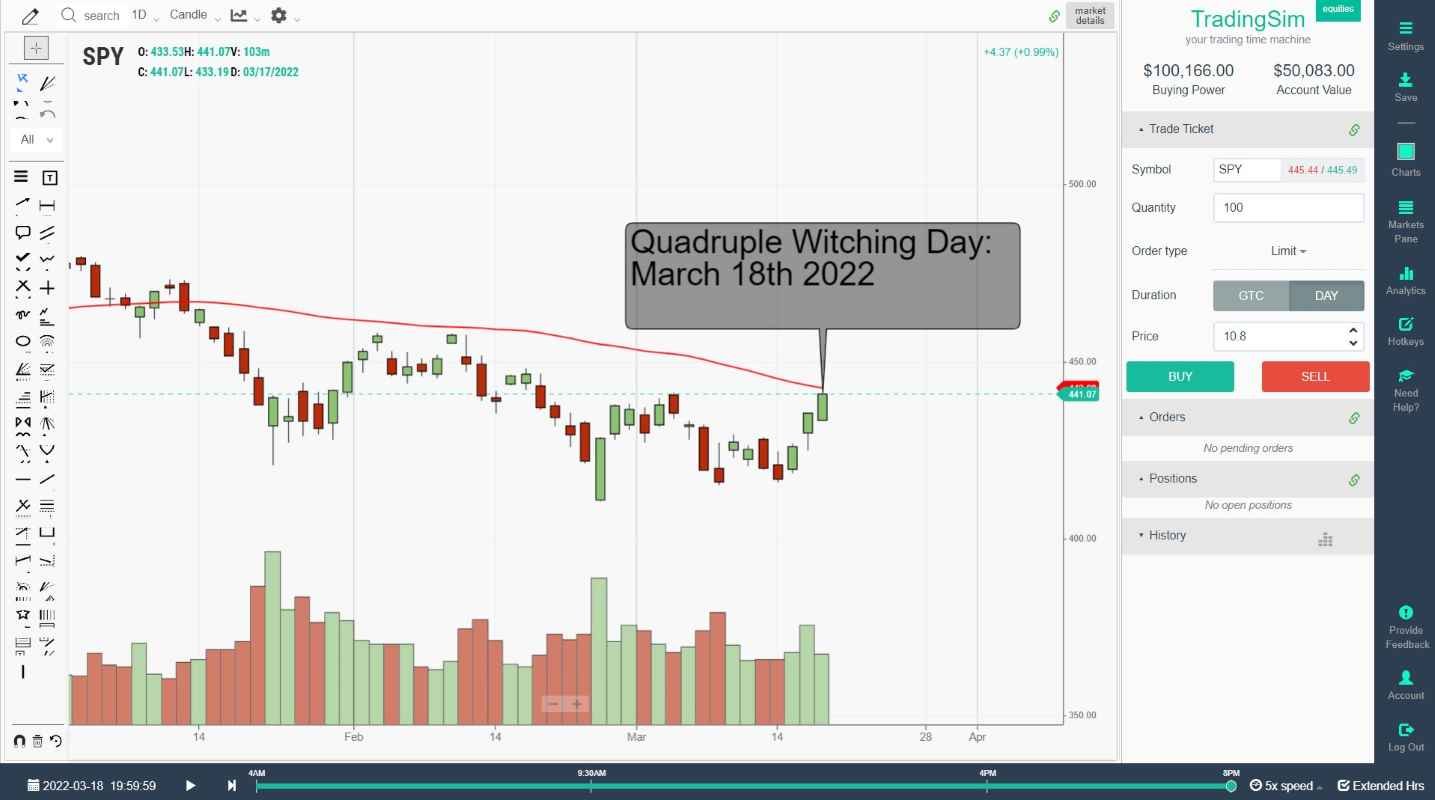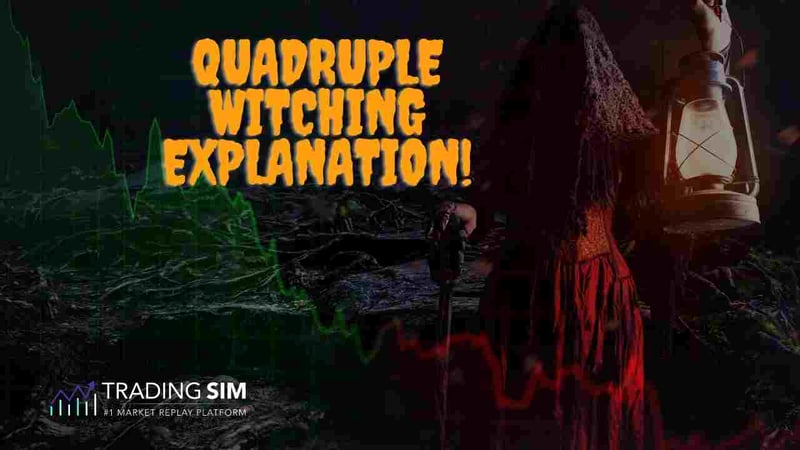If you are under the impression that every trading session is the same, then we are sorry to say this, but you are sorely mistaken. There are certain dates throughout the calendar year that hold more significance than others. For example, every month has an OPEX or Options Expiration day which is generally the third Friday of each month.
There are other dates as well including certain times of the month or quarter where funds and ETFs will rebalance their portfolios. But perhaps most significantly, there is an event that happens four times per year, once in each quarter, that has become infamous. It is called the quadruple witching day.
Quadruple Witching Explanation
Quadruple Witching or quad witching is the perfect storm of events. The quad witch day takes place on the third Friday of the third month of each quarter (March, June, September, and December). On quad witching days, we see the expiration of four different types of derivatives contracts: stock index futures, index options, stock options, and single stock futures. These trading days typically see much higher trading volume, although not necessarily more market volatility.
How does quadruple witching affect the market?
With all of these contracts expiring on the same day, quad witching does tend to lead to higher trading volume during these sessions. As the contracts expire, investors need to either close out the trades, let them expire in the money, or roll them forward. Whichever action they choose adds trading volume to the overall market.
While the first assumption would be that this added trading volume will lead to added market volatility, that’s not always the case. Contract expirations generally do not lead to over-dramatic price action in the underlying stocks. Some would argue that options trading, in general, doesn’t typically affect the stock price, except for extraordinary situations like a gamma squeeze.
One historical result that has been observed is that the broader markets, particularly the S&P 500, tend to trade lower in the week following quad witching days. The reason for this is unclear, although it is likely due to a temporary exhaustion of the demand for stocks. Other than this noted trend, quad witching days do not seem to have a major impact on the stock market.
What happens on quadruple witching day?
Quadruple witching day is when four different derivative contracts expire on the same day, forcing traders to take action on these trades. The four different contracts are index futures, index options, stock futures, and stock options.
Investors can choose to roll these contracts forward by selling them and purchasing contracts with expiration dates that are further out. They can also close out the trades by selling the contracts or letting them expire and get assigned the shares of the underlying stock.
Is quadruple witching good or bad?

The answer to this is probably, neither. Since quadruple witching doesn’t seem to have a direct impact on market volatility, it doesn’t necessarily affect the prices of the underlying stocks. Since these are derivatives and mostly futures contracts, quad witching doesn’t add volatility to the stock market like some would assume.
If you include the trend of the markets falling post-quad witching, then there is an argument for saying it is a bad thing. With all of these contracts expiring on the same date, it certainly adds overweight trading volume for that particular session. Still, the overall effect of quad witching is minimal to the stock markets so it is still a bit of a stretch to call the event good or bad.
Is quadruple witching bullish or bearish?
It’s difficult to pinpoint an actual trend or market sentiment from a quad witching day. Some will point to it being a bearish catalyst as we can sometimes see some market downturn during the last hour of the quad witching session. This is caused by long positions prevailing against short ones, which does have the ability to cause stock prices to fall.
Generally, it isn’t enough to attribute quadruple witching as a bearish event.
If we count the trend of the markets falling in the week after the quad witch then again, there is an argument for it being bearish. Overall, quad witching is fairly neutral, and is looked at as just an extraordinary day rather than something to be feared or celebrated.
Quadruple witching and volatility
While it is true that quadruple witching doesn’t always lead to market volatility, it can happen. Of course, when you have four derivatives expiring on the same day, it could lead to some price volatility for the underlying stocks, especially if investors choose to close out their positions.
Normally options trading does not have a direct impact on the underlying stock price. In fact, it is usually the stock price that has the effect on the price of the options contract.
A higher trading volume can mean there is a higher than normal number of buyers or sellers. If a stock has more of either of these, then the price can be volatile. This is especially true in the last hour of trading on quad witching day, which is usually referred to as the quad witching hour.
Although it hasn’t been proven that quad witching regularly causes market volatility, if you're spooked, it’s easy to just avoid trading options or stocks on these four days each year.
When is quadruple witching day in the stock market?
Quadruple witching days occur on the third Friday of the third month in each quarter. This means that the quad witching takes place on the third Friday in the months of March, June, September, and December.
Normally the third Friday of each month is Options Expiration day anyways, but it just so happens that for each of these four months, the OPEX coincides with the expiration of three other derivatives markets.
When is the next quadruple witching day?
The next quadruple witching day in 2022 is scheduled for Friday, June 17th, for the close of the second quarter of the year. Following June 17th is September 16th for the third quarter and December 16th for the fourth quarter later this year. The first quad witching date of 2022 has already passed and it took place on Friday, March 18th.
Quadruple witching vs triple witching
This one might be a bit confusing as you've likely heard about both triple witching and quadruple witching at some point. Let us clear up this confusion for you: triple witching as an event no longer exists.
In November of 2002, single stock futures began trading on the US stock market. Until then, it was only index futures, index options, and stock options that made it triple witching. When stock futures were added as the fourth derivatives contract that expires on the same date, it became quad witching.
Conclusion: Quadruple Witching
The quadruple witching date is a significant one on the financial calendar, but overall, the effects on the stock markets are actually pretty minimal.
Quad witching days happen on the third Friday of the third month of each quarter, four times per year. On this day, the markets see the simultaneous expiry of four different derivatives contracts: index futures, index options, stock futures, and single stock options.
While these events can create higher trading volume, the effect of the options market on the underlying stock is limited. The next quad witching day in 2022 is on Friday, June 17th.








 Day Trading Indicators
Day Trading Indicators 
